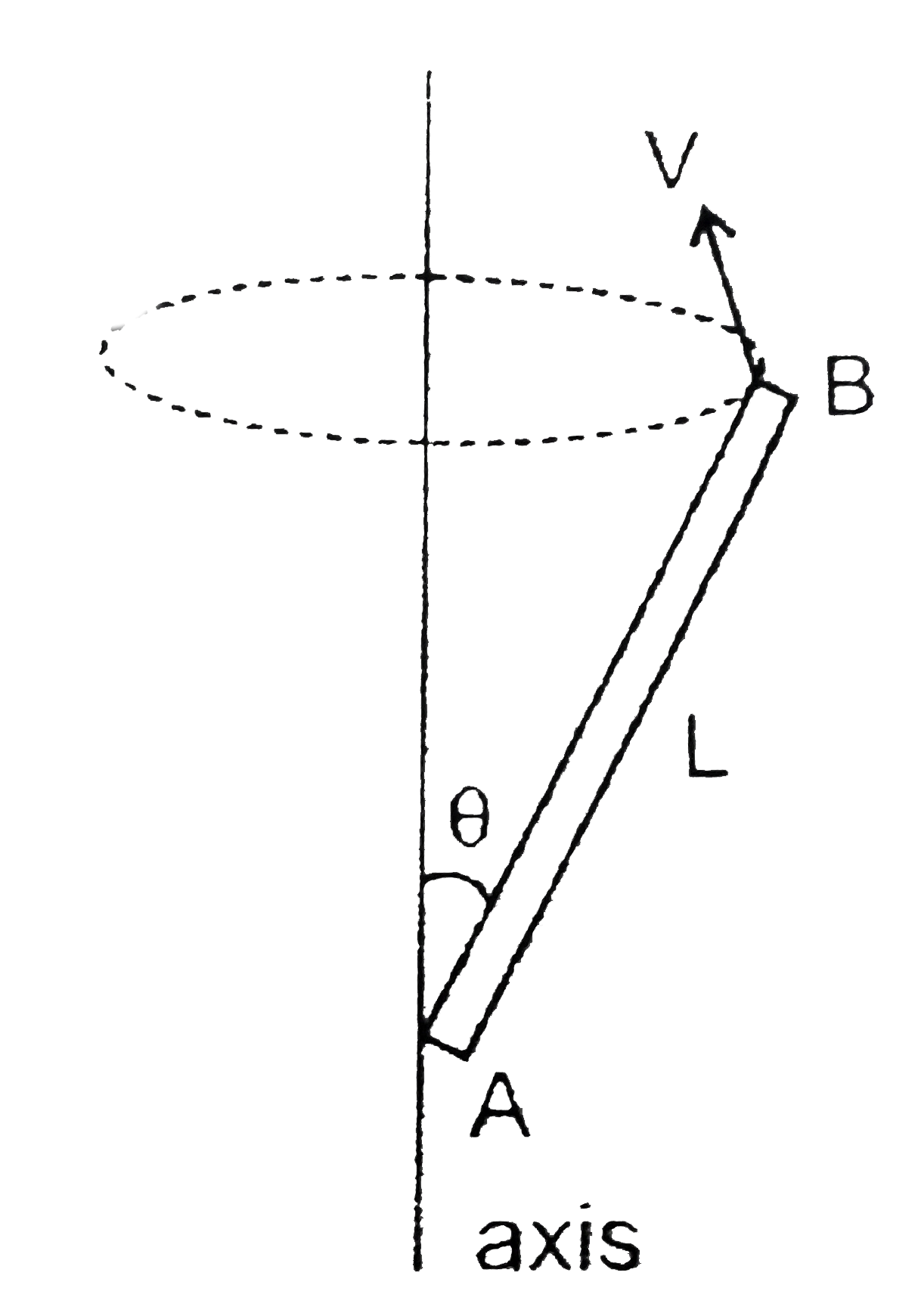One end of a thin rod is attached to a pivot, about which it can rotate without friction. Air resistance is absent. The rod has a length of 0.80 m and is uniform. It is hanging vertically straight downward. The end of the rod nearest the floor is given a linear speed v0, so that the rod begins to rotate upward about the pivot. What must be the value of v0 such that the rod comes to a momentary halt in a straight-up orientation, exactly opposite to its initial orientation?
6.9m/s
5.6m/s
4.7m/s
8.1m/s
The correct Answer is:A
To solve the problem, we need to determine the initial linear speed v0 that must be given to the end of a uniform rod of length L=0.80m so that it rotates upward and comes to a momentary halt in a vertical position opposite to its initial orientation.
1. Identify the Initial and Final Positions:
- The rod is initially hanging straight down (vertical downward position).
- The final position is vertical upward, opposite to the initial position.
2. Define the Center of Mass:
- The center of mass of the uniform rod is located at a distance of L2 from the pivot point (the end of the rod attached to the pivot).
3. Apply Conservation of Energy:
- Initially, when the rod is in the downward position, it has rotational kinetic energy and no potential energy (taking the reference point at the pivot).
- At the momentary halt in the upward position, the rod has potential energy and no rotational kinetic energy.
4. Calculate Initial Rotational Kinetic Energy:
- The moment of inertia I of the rod about the pivot point is given by:
I=13mL2
- The initial rotational kinetic energy KEi is:
KEi=12Iω2
- Here, ω is the angular velocity, which can be related to the linear speed v0 at the end of the rod:
ω=v0L
5. Calculate Final Potential Energy:
- When the rod reaches the upward position, the height of the center of mass from the pivot is L (it rises L from its initial position).
- The potential energy PEf at this position is:
PEf=mgh=mgL
6. Set Up the Energy Conservation Equation:
- According to the conservation of energy:
KEi=PEf
- Substituting the expressions for kinetic and potential energy:
12(13mL2)(v20L2)=mgL
7. Simplify the Equation:
- Cancel m and L2 from both sides:
16v20=gL
8. Solve for v0:
- Rearranging gives:
v20=6gL
- Taking the square root:
v0=√6gL
9. Substitute the Values:
- Using g=9.8m/s2 and L=0.80m:
v0=√6×9.8×0.80
- Calculate:
v0=√47.04≈6.86m/s
Final Answer:
The required initial speed v0 is approximately 6.86m/s.
- The rod is initially hanging straight down (vertical downward position).
- The final position is vertical upward, opposite to the initial position.
- The center of mass of the uniform rod is located at a distance of L2 from the pivot point (the end of the rod attached to the pivot).
- Initially, when the rod is in the downward position, it has rotational kinetic energy and no potential energy (taking the reference point at the pivot).
- At the momentary halt in the upward position, the rod has potential energy and no rotational kinetic energy.
- The moment of inertia I of the rod about the pivot point is given by:
I=13mL2
- The initial rotational kinetic energy KEi is:
KEi=12Iω2
- Here, ω is the angular velocity, which can be related to the linear speed v0 at the end of the rod:
ω=v0L
- When the rod reaches the upward position, the height of the center of mass from the pivot is L (it rises L from its initial position).
- The potential energy PEf at this position is:
PEf=mgh=mgL
- According to the conservation of energy:
KEi=PEf
- Substituting the expressions for kinetic and potential energy:
12(13mL2)(v20L2)=mgL
- Cancel m and L2 from both sides:
16v20=gL
- Rearranging gives:
v20=6gL
- Taking the square root:
v0=√6gL
- Using g=9.8m/s2 and L=0.80m:
v0=√6×9.8×0.80
- Calculate:
v0=√47.04≈6.86m/s
The required initial speed v0 is approximately 6.86m/s.
Topper's Solved these Questions
- RIGID BODY DYNAMICS-IIBook:RESNICK AND HALLIDAYChapter:RIGID BODY DYNAMICS-IIExercise:PRACTICE QUESTIONS (More than One Option Correct Type)
Explore 2 Videos
- RIGID BODY DYNAMICS-IIBook:RESNICK AND HALLIDAYChapter:RIGID BODY DYNAMICS-IIExercise:PRACTICE QUESTIONS(Linked Comprehension)
Explore 3 Videos
- RIGID BODY DYNAMICS-IIBook:RESNICK AND HALLIDAYChapter:RIGID BODY DYNAMICS-IIExercise:PROBLEMS
Explore 41 Videos
- RIGID BODY DYNAMICS - IBook:RESNICK AND HALLIDAYChapter:RIGID BODY DYNAMICS - IExercise:PRACTICE QUESTIONS (INTEGER TYPE))
Explore 3 Videos
- TEMPERATURE, ZEROTH LAW OF THERMODYNAMICS AND THERMAL EXPANSION Book:RESNICK AND HALLIDAYChapter:TEMPERATURE, ZEROTH LAW OF THERMODYNAMICS AND THERMAL EXPANSION Exercise:PRACTICE QUETIONS (Integer Type)
Explore 4 Videos
Similar Questions
A rod of length l is pivoted about a horizontal , frictionless pin through one end. The rod is released from ret in a vertical position. Find the velocity of the CM of the rod when the rod is inclined at an angle θ from the vertical.

View SolutionA uniform. rod of length l can rotate without friction about an axis passing through its upper end (Fig). The rod is deflected by an angle a0 and let go. Find the speed of the lower end of the rod as a function of the angle α

View Solution
Knowledge Check
A uniform rod AB of mass m and length 2a is falling freely without rotationb under gravity with AB horizontal. Suddenly the end A is fixed when the speed of the rod is v. The angular speed which the rod begains to rotate is
Av2aB4v3aCv3aD3v4aA uniform rod smoothly pivoted at one of its ends is released from rest. If it swings in vertical plane, the maximum speed of the end P of the rod is.
 .A2√3glB√3glC2√2glD√gl
.A2√3glB√3glC2√2glD√glA uniform rod of length l is from rest such that it rotates about a smooth pivot. The angular speed of the rod when it becomes vertical is.
 .A2√6g7lB√6g7lC2√3g7lD√3g7l
.A2√6g7lB√6g7lC2√3g7lD√3g7l
A rod of length 2 m is held vertically with one of its end on the floor. It is then allowed to fall. Calculate the speed of the other end when it strikes the floor. Assume that the end of the rod which is on the floor does not slip.
View SolutionA rod AB of mass m and length L is rotating in horizontal plane about one of its ends which is pivoted. The constant angular speed with which the rod is rotating is ω. The force applied on the rod by the pivot is
View SolutionA uniform rod of mass m and length L is fixed to an axis, making an angle θ with it as shown in the figure. The rod is rotated about this axis so that the free end of the rod moves with a uniform speed ‘v’. Find the angular momentum of the rod about the axis. Is the angular momentum of the rod about point A constant?

View SolutionA conical pendulum, a thin uniform rod of length l and mass m, rotates uniformly about a vertical axis with angular velocity ω(the upper end of the rod is hinged). Find the angle θ between the rod and the vertical.
View Solution
A uniform rod AB of mass m and length L rotates about a fixed vertical axis making a constant angle θ with it as shown in figure. The rod is rotated about this axis, so that point B the free end of the rod moves with a uniform speed V in the horizontal plane then the angular momentum of the rod about the axis is:
View Solution

